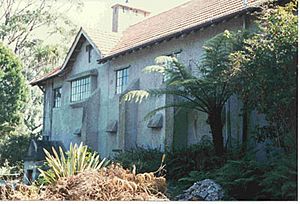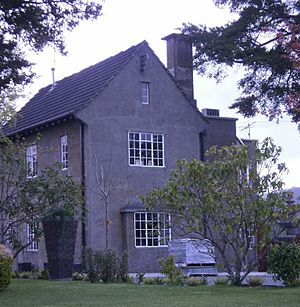James Chapman-Taylor facts for kids
Quick facts for kids
James Chapman-Taylor
|
|
|---|---|
| Born |
James Walter Chapman-Taylor
24 June 1878 London, England
|
| Died | 25 October 1958 (aged 80) Lower Hutt, New Zealand
|
| Nationality | New Zealander |
| Buildings | 97 houses |
James Walter Chapman-Taylor (born June 24, 1878 – died October 25, 1958) was a famous New Zealand architect. He was known for designing many beautiful homes. His houses were often inspired by the Arts and Crafts movement, which focused on handmade items and natural materials. Chapman-Taylor was also a talented builder, furniture designer, and photographer. He even had a special interest in astrology!
Contents
His Early Life
James Walter Chapman-Taylor was born in London, England, in 1878. His parents were Theodore Chapman-Taylor and Ada Thomas. In 1879, his father, Theodore, moved to New Zealand. He bought some land near Stratford in the Taranaki Region.
James, his mother, and his younger brother joined Theodore in New Zealand in June 1880. The family then became dairy farmers.
Becoming an Architect
As a teenager, James decided that farming was not for him. He chose to become an apprentice to a local builder instead. After finishing his training, he built his very first house. It was a single-story wooden home for his parents on their farm in Stratford.
On April 12, 1900, he married Mary Gibson in Stratford. In 1903, he started an architecture and design course. He studied with the International Correspondence Schools from Pennsylvania, USA. In 1904, he moved to Wellington after working on the Taihape railway station. Around 1907, he began using the surname Chapman-Taylor.
Travel and Inspiration
In 1909, Chapman-Taylor traveled to England. He wanted to study and see the work of famous architects. These included C.F.A. Voysey, Baille Scott, and Parker and Unwin. They were well-known for designing homes.
When he returned to New Zealand, Chapman-Taylor was determined. He wanted to follow the main ideas of good home design. He aimed to build houses with great skill and care. He was inspired by the Arts and Crafts movement. This style used ideas from old English country cottages. He wanted to bring these ideas to New Zealand, using local materials and settings.
Unique Furniture Designs
Chapman-Taylor believed in using a special hand-finishing technique. He used a tool called an adze to shape the wood. He felt this gave the wood a "woody character." It showed that the piece was handmade. This method also made the wood reflect light in a way that added "interest and beauty." He thought it needed no other decoration.
He often used a rich, dark wood called jarrah in his houses and furniture. He used it so much that people sometimes called him 'Jarrah Taylor.' A chair he made in 1910 shows his unique style. It highlights his use of the adze and the simple, honest principles of the Arts and Crafts movement.
His Signature Style
As Chapman-Taylor grew as an architect, his designs became more connected. He started using concrete as his main building material. He would finish the outside walls with a rough plaster. He followed the ideas of John Ruskin and William Morris, who were important figures in the Arts and Crafts movement. This made his work very consistent.
Chapman-Taylor was confident in his own ideas. He felt free to try new things. His houses were designed down to the smallest detail. Many of his buildings still have furniture pieces that he designed himself.

His houses often had high roofs with special Marseille tiles. They featured plain, rough plaster walls and windows with small panes of glass. Inside, he used a lot of hand-shaped wood, which became a key part of his style. Chapman-Taylor's homes clearly showed his unique touch. They were his own version of the English cottage style from the Arts and Crafts movement.
Chapman-Taylor designed many houses all over New Zealand. You can find several examples in Taranaki. One famous building there is known as Wilkie's Castle, in Wai-iti. In Havelock North, he designed the Whare Ra building for a group called the Stella Matutina order.
James Chapman-Taylor passed away on October 28, 1958, at the age of 80. He died from a sudden illness.
J. Stacpoole and P. Beaven wrote in their book, New Zealand Art: Architecture 1820-1970: "All Chapman-Taylor’s houses are economical in their use of space, intimate in detailing, and extremely satisfying to live in."



